
“Let the clean air blow the cobwebs from your body. Air is medicine.”
–Lillian Russell (1862-1922)
There is a priceless gift you can give to yourself, and to your family: the gift of health. Most of us try to eat nutritiously, and exercise to keep our minds and bodies strong. We may take vitamins and supplements, meditate, or know the importance of sleep at night. There is, however, another element to consider. The environment we live in either supports us or stresses us. We’ve long thought of the environment as something “out there”— acid rain, air pollution, a diminishing ozone layer. As important, though, is our indoor environment, and the quality of the air we breathe in our homes.
I have been privileged to work as an interior designer for many years, in some of the most beautiful spaces on earth. Nantucket, in particular, has long been my home and one of my favorite places to design elegant interiors. The crisp ocean air blows cobwebs away from mind and body; homes there reflect the invigorating effects of sand, salt air and sea. The natural next step is to ensure that the air in our houses remains as pure as the breezes that first blew in, even when the windows are closed. That’s why creating homes that are both warmly inviting and supportive of health has been my design passion since 1987.
What causes indoor air pollution? The list is longer than you might imagine, and includes chemicals like formaldehyde and polyurethane, emitted from both furniture and wood used for cabinets, stairs, banisters and trimwork. Fabrics and stuffing from upholstered furniture can be a source of noxious indoor fumes; mattresses and bedding can be laden with chemicals intended to keep us safe (for instance, flame retardants) and yet be dangerous to our fragile immune systems. Paints and finishes emit VOCs (volatile organic compounds), a term for chemicals that emit harmful gases.
As daunting as this sounds, there is good news. Manufacturers are responding to consumers’ demands for healthier products, and today we can choose from low-toxic building materials, low VOC paints and finishes, and fabrics and stuffings made with 100% natural materials like cotton and wool. Eco-friendly wood products are available that are FSC-certified, a designation from the Forest Stewardship Council ensuring that the wood was grown and harvested in a way that protects forests for the long term. If you are planning to build a new home, or intend to renovate an existing one, I urge you to consider these materials. Not only is it better for you and your family, but when the day comes to sell your house, prospective buyers will surely be in the market for sustainable construction and design. (Homeowner interest is growing: according to the U.S. Green Building Council, the market for green building products and services has catapulted from $7 billion in 2005 to more than $12 billion today).
If you’re simply considering redecorating, there are still good choices to be made. Bare floors are easier to keep clean and free of allergens, yet they can be stunning when painted in mosaic patterns, or tiled in colors and textures reminiscent of carpet. Where rugs are used, 100% organic wool is a wise choice. Antique furniture has always been desired for its unique blend of beauty and history; it has the added benefit of no longer emitting harmful gases from wood or finishes.

If you are like one of four Americans, you may well suffer from allergies and asthma. Children, especially, are prone to these ailments. Good home design should include a combination HEPA and carbon filtration system for household ventilation, designed to remove both airborne particulates like dander and pollen, as well as chemicals, gases and odors. It is imperative to properly ventilate kitchens and baths to prevent the growth of mold; hiring a designer knowledgeable in sustainable construction can literally be a breath of fresh air for your whole family.
I have always emphasized natural light and fresh air in my designs. At first, it was an intuitive response to my love of sunlight and nature and the joyful feeling of a home that reflects the best of the outdoor world; today, I know that it is crucial for indoor air quality as well. This is a wonderful time for all of us to take a deep breath, and resolve to live lightly on the earth, both indoors and out.







